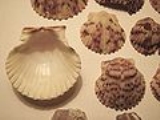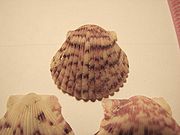
Atlantic calico scallop
Encyclopedia
The Atlantic calico scallop, Argopecten gibbus, is a species
of medium-sized edible saltwater clam
, specifically a scallop
, a marine
bivalve mollusk in the family Pectinidae
, the scallops.
This species was once the basis of an important fishery, but in recent years catches have been low.http://www.sms.si.edu/IRLSpec/Argope_gibbus.htm
The exterior coloration of the upper (left) valve is dark yellow or pink, with striking blotches of red which sometimes form stripes. The lower (right) valve of this scallop is whitish with small reddish or purple spots. It has a white interior, often with brown patches on the "ears" and top edge.
The lively outer coloration of the shell of this species is what gave rise to its popular name: in the USA, "calico" was for many years an inexpensive but colorful fabric printed with small flower patterns.
and southwest of Beaufort Inlet
and lives in up to 100-foot depths. The shells are commonly found washed up on sound and ocean beaches.
 This species ranges from Delaware
This species ranges from Delaware
to Brazil
and is still sometimes fished commercially.
Valve color and shell morphometry distinguish calico scallops from related species. The Atlantic calico is distinguished by the yellowish to white coloration and splotchy patches of bright red, maroon, or lavender. It is slightly convex in the left (upper) valve (Broom 1976).
Two other scallops are documented to occur in the Indian River Lagoon
and are similar in size and shape. One is the Bay scallop, (Argopecten irradians
), which generally has a uniform gray to gray-brown coloration with distinct convexity of the right (lower) valve. The other is the Rough scallop
, (Aequipecten muscosus), which may also be mistaken for the Atlantic calico scallop. The rough scallop however has unequal ears and has sharp scales on the lower surface of the ribs. It also has coloration which ranges into shades of yellow and brown.
Species
In biology, a species is one of the basic units of biological classification and a taxonomic rank. A species is often defined as a group of organisms capable of interbreeding and producing fertile offspring. While in many cases this definition is adequate, more precise or differing measures are...
of medium-sized edible saltwater clam
Clam
The word "clam" can be applied to freshwater mussels, and other freshwater bivalves, as well as marine bivalves.In the United States, "clam" can be used in several different ways: one, as a general term covering all bivalve molluscs...
, specifically a scallop
Scallop
A scallop is a marine bivalve mollusk of the family Pectinidae. Scallops are a cosmopolitan family, found in all of the world's oceans. Many scallops are highly prized as a food source...
, a marine
Marine (ocean)
Marine is an umbrella term. As an adjective it is usually applicable to things relating to the sea or ocean, such as marine biology, marine ecology and marine geology...
bivalve mollusk in the family Pectinidae
Pectinidae
The Pectinidae are a family of bivalve mollusks including the scallop and closely related to the clam and oyster. They are hermaphrodite, and the male gonads mature first. Pectinidae can live attached by means of a filament they secrete, or are simply recumbent. Their valves can propel them...
, the scallops.
This species was once the basis of an important fishery, but in recent years catches have been low.http://www.sms.si.edu/IRLSpec/Argope_gibbus.htm
Description
This species grows up to three inches in maximum width, and is similar in shape and sculpturing to the Atlantic bay scallop. Both valves of the shell are cupped. The shell near the hinge is extended into "ears", as is the case in all scallops. The shell of the Atlantic calico scallop has about twenty radial ribs, which are sometimes roughened by growth lines.The exterior coloration of the upper (left) valve is dark yellow or pink, with striking blotches of red which sometimes form stripes. The lower (right) valve of this scallop is whitish with small reddish or purple spots. It has a white interior, often with brown patches on the "ears" and top edge.
The lively outer coloration of the shell of this species is what gave rise to its popular name: in the USA, "calico" was for many years an inexpensive but colorful fabric printed with small flower patterns.
Habitat
The Atlantic calico scallop lives in the ocean (it is not found in bays) east of Cape LookoutCape Lookout
Cape Lookout can refer to:*Cape Lookout , in the United States*Cape Lookout , in the United States*Cape Lookout...
and southwest of Beaufort Inlet
Beaufort Inlet
Beaufort Inlet also locally known as Pallinup Estuary is an inlet located in the Great Southern region of Western Australia about east of Albany. There is a similarly named inlet leading from the Atlantic Ocean to the town of Beaufort, N.C...
and lives in up to 100-foot depths. The shells are commonly found washed up on sound and ocean beaches.

Delaware
Delaware is a U.S. state located on the Atlantic Coast in the Mid-Atlantic region of the United States. It is bordered to the south and west by Maryland, and to the north by Pennsylvania...
to Brazil
Brazil
Brazil , officially the Federative Republic of Brazil , is the largest country in South America. It is the world's fifth largest country, both by geographical area and by population with over 192 million people...
and is still sometimes fished commercially.
Valve color and shell morphometry distinguish calico scallops from related species. The Atlantic calico is distinguished by the yellowish to white coloration and splotchy patches of bright red, maroon, or lavender. It is slightly convex in the left (upper) valve (Broom 1976).
Two other scallops are documented to occur in the Indian River Lagoon
Indian River Lagoon
The Indian River Lagoon is a grouping of three lagoons: Mosquito Lagoon, Banana River, and the Indian River, on the Atlantic Coast of Florida. It was originally named Rio de Ais after the Ais Indian tribe, who lived along the east coast of Florida....
and are similar in size and shape. One is the Bay scallop, (Argopecten irradians
Argopecten irradians
Argopecten irradians, formerly classified as Aequipecten irradians, common names the "Atlantic bay scallop" or "bay scallop", is an edible species of saltwater clam, a scallop, a marine bivalve mollusk in the family Pectinidae, the scallops....
), which generally has a uniform gray to gray-brown coloration with distinct convexity of the right (lower) valve. The other is the Rough scallop
Rough scallop
The rough scallop, Aequipecten muscosus, grows up to . It has a small, scallop-shaped shell with about twenty strong ribs which have many erect scales or small spines near the margin...
, (Aequipecten muscosus), which may also be mistaken for the Atlantic calico scallop. The rough scallop however has unequal ears and has sharp scales on the lower surface of the ribs. It also has coloration which ranges into shades of yellow and brown.

